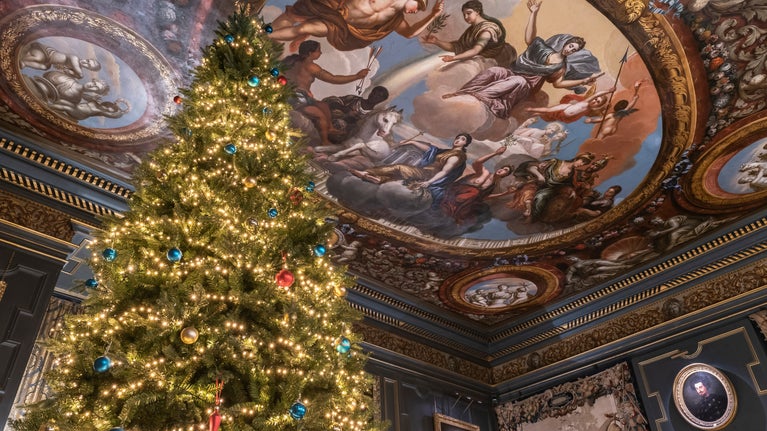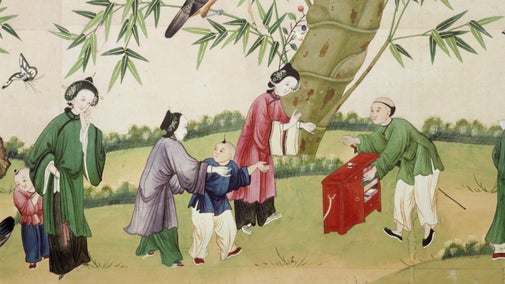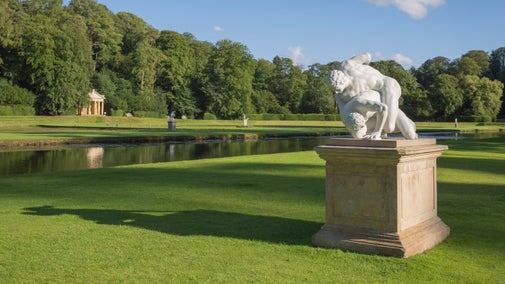
Immerse yourself in history
Meet people from the centuries gone by, learn about the unique artworks in our care and understand more about historic traditions.

The East India Company was probably the most powerful corporation in history. At its height, it dominated global trade between Europe, South Asia and the Far East, fought numerous wars using its own army and navy, and conquered and colonised modern day India, Pakistan, Bangladesh and Burma.
From its foundation in 1600 the Company was granted a monopoly on British trade with the East, and the products it brought back soon began appearing in British homes. During the eighteenth century, cottons, indigo, porcelain, tea, and silks imported by the Company became incredibly popular. On the back of such lucrative trade, many Britons became wealthy, while even those of modest middle-class means benefited from share ownership.
During the seventeenth and early eighteenth centuries the Company trafficked enslaved people taken from Africa across the Indian Ocean to work on plantations in India and Indonesia.
By the late eighteenth century, however, customers and rivals increasingly complained of unfair pricing and practices. Eventually, in 1813, the government acted to strip the Company of its privileges and open its markets to free trade.As a result, it was left with a monopoly on only a few key products, principally tea, which it purchased from China.
As the Chinese authorities would only accept silver in exchange, the Company looked to more profitable methods of exchange and increasingly relied on smuggling opium. This resulted in a terrible human cost and two ‘Opium Wars’ between Britain and China.

From its earliest days the Company had sought to protect its presence in India through the building of fortified outposts and field armies. Pushed on by threats from other European powers and local rulers, plus the individual ambition of several key figures, the Company’s military machine expanded to fight numerous wars.
With the victories at Plassey (1757) and Buxar (1764) the Company forced the defeated Mughal emperor, Shah Alam II, to surrender the territories of Bengal, Bihar and Orrisa. From this point onwards the East India Company became rulers, able to create the laws and levy taxes. For almost a century after this the Company waged war until it had conquered the entirety of the Sub-continent and ruled over a population exceeding 200 million.
As both merchant and ruler, the Company maintained high prices and charged its tax collectors with extracting as much revenue from the Indian population as possible, which opponents argued reduced many to subsistence poverty. The Company’s policies and inaction also directly contributed to the ill effects of crop failures, such as in Bengal during 1769-70, where the resulting famine killed somewhere between 1-4 million people.
As foreign conquerors, the Company felt itself in perpetual danger of rebellion and overthrow and was particularly wary of interfering in Indian religions. That said, the Company could be highly interventionist, particularly in terms of law and order, where it sought to maintain an image of unassailable power and was not beyond brutal retribution.
From the early nineteenth century, tensions grew with the introduction of Christian missionaries and the Company’s move to mould Indian society more in the image of Britain. Combined with continued misrule and unrest in the army, this exploded into violence in 1857.
The rebellion which broke out that year spelt the end of the East India Company, and after a bloody campaign of suppression, the British government transferred India to its direct control.
Starting his career as a junior mercantile agent, Robert Clive rose to become Governor of Bengal and Commander-in-Chief of the East India Company's army. Despite no formal military training Clive successfully led numerous campaigns, the most famous being the Battle of Plassey. It was also Clive who extracted territorial control for the Company as a result. For himself, he took a vast fortune in gold, silver and jewels from the treasury of the defeated Siraj ud-Daulah as spoils of war.
On his return from India, Robert Clive bought the Claremont estate and decided to have the house demolished and a new Palladian mansion and landscape garden constructed. The task was given to two giants of eighteenth century design, Henry Holland and Lancelot 'Capability' Brown. Having spent a huge sum of money, Clive was not destined to enjoy his new estate, as he died the year of its completion in 1774.
Robert's eldest son, Edward Clive, inherited his father's fortune but was in want of status and a wife. Henrietta Herbert, eldest daughter of the Earl of Powis, had a prestigious name, however the family was in serious debt. Their marriage in 1784 was therefore a welcome occasion for both. The couple would travel to India together during Edward's posting as Governor of Madras and return home with a large collection of Indian objects. These they installed at Powis Castle and now make up the core collection of the Clive Museum.

Britain’s increasing involvement in India had an influence reaching far beyond those who travelled East. Alongside the domestic commodities, Indian and ‘Oriental’ architecture, interiors and objects also proliferated. Individual objects, either imported or created in Britain in the style of Asian goods, found their way into most homes. The Lower India Room at Penrhyn Castle, created in the 1830s, is a stunning example of this trend for all things ‘Oriental’.
Francis Sykes was Robert Clive’s right hand man in Bengal and crucial to the dramatic rise of the East India Company. Having had a senior Company position and his own trading network, he returned to Britain an extremely wealthy man. Sykes purchased himself a place in Parliament and bought the Basildon Park estate, where he commissioned an impressive Palladian mansion to be built.
In many ways Sykes was the archetypal “nabob”, the 18th century name for a brash and newly rich East India Company employee, being denounced for the scale and acquisition of his fortune. Unlike Clive, who proudly displayed his Indian collections around his many houses, Sykes appears to have furnished his home with few Indian objects, preferring instead to buy Chinese porcelain imported through Company connections.

Tipu Sultan, ruler of Mysore, was one of the Company's fiercest and most implacable enemies. After several wars, he was eventually killed during the British conquest of Seringapatam in 1799, by the forces of expansionist Governor-General, Lord Wellesley, and his brother, the future Duke of Wellington. The richest kingdom in South India therefore fell into British hands and Tipu's palaces were pillaged. This finial, made of gold and set with rubies, diamonds and emeralds, was broken from Tipu's throne and given by Wellesley to Henrietta Clive (née Herbert), and is now on display in the Clive Museum at Powis Castle.H3 - Tipu Sultan's tent
This tent was used by Tipu Sultan as his headquarters in the field while he made progresses about his territories, and capture by the Company following his defeat. Made of cotton chintz and patterned with acanthus leaves and flowers, it was amongst the Indian relics acquired by Edward Clive while he was Governor of Madras. At Powis it was used as a marquee for garden parties held by the family, and is now on partial display.
This oil painting depicts a puja, a Hindu prayer ritual, in this case performed in worship of Shiva. The painting, part of a series and dated 1804, is by British artist Thomas Daniell who spent 10 years in India painting various subjects for the British market. The seated figure is likely a high caste Indian, who is attended by a man servant with a fan. Such images grew in popularity alongside British rule, and were part of a general rage for all things Indian, led by the Prince Regent at the turn of the nineteenth century. This example and others in the series were bought by Richard Colt Hoare for the family home at Stourhead.

This article contains contributions from Kieran Hazzard from the University of Oxford who specialises in Britain and India during the eighteenth and nineteenth centuries. His research particularly covers the encounter between British Radicalism and India, and the role of material objects in fashioning the Raj both in reality and in story. His wider interests include constitutional thought, the consumption of history, print culture, and the East India Company. Kieran is a contributor to the Trusted Source project.

Meet people from the centuries gone by, learn about the unique artworks in our care and understand more about historic traditions.

A hub for multi-disciplinary research projects and research engagement at the University of Oxford
Find out more about our Trusted Source articles, which were created in partnership with the University of Oxford, and explore topics related to the special places in our care.

We look after the largest collection of historic Chinese wallpapers on permanent public display in the world. Learn more about the evolution of paper wallcoverings and the different styles through the centuries.

Explore a selection from more than half a million books and manuscripts in the collections we care for. Libraries Curator Tim Pye takes a closer look at some of the most significant works.

Taking part in sports is a popular pastime all over the world. From the origins of the Olympics to the evolution of cricket, discover sports through the ages at the collections and places we look after.
